Cactus plants have been popular for quite a while now. Their popularity is evident since their image can be found everywhere, from greeting cards to emojis.
When talking about their experience with cactus plants, enthusiasts say that they get completely absorbed in taking care of their cactus plants once they start.
You can also experience this joy firsthand, either by buying a cactus plant from your local store or potting the one growing in your backyard.
Either way, you need to find out what kind of cactus you have to take care of it.
You need to know how your cactus plant is different. This way, you can take better care of it and know what to do when something goes wrong.
There are many desert plants, and it can become tedious to know the differences between them. Cactus plants are wholly unique. However, since they are plants, they tend to look most similar.
You must know the different types that are present. You will know which types of cactus plants you have if you know how to identify them.
In the article below, we will describe how you can identify your cactus plant properly.
Table of Contents
What are the ways that you can identify the type of cactus you have? There are around a hundred types of cactus plants in the world.
We can identify some of them due to their physical features. You can also identify cactus plants using the climate in which they exist.
Other factors you can use to determine the cactus’s type include its natural habitat, needles/spines, and coloration. Shape, color, height, and seeds also play a significant role in identifying the cactus.
Indicators of Different Cactus Plants
There are over 200 species of cacti plants. Some of them are edible, some are medicinal, and some are ornamental. The cacti plants listed below are some of the most common ones found growing wild.
When differentiating one cactus plant from the other, observe their physical aspects. Some of the most notable features you can check out are:
Flowering Style
The flowering style is one of the most critical aspects of the cactus species. Each cactus type is set apart from all other cactus types due to its flowering style.
This information can help you identify whether the plant is epiphytic or terrestrial. Epiphytes are plants that can grow in humid climates without any extra moisture.
Epiphytes also need no solid connection to the earth. Other plants like the Terrestrials need a whole root network and can access soil directly.
The pattern of the cactus plant’s flowers can also indicate its type. There are many different cactus plants that you can use to understand all of their classes.
Cactus species such as barrel and Saguaro showcase radial patterns that can sprout in more ways than one. Certain columnar species like the Cardon can also display vertical stripes or zigzags in different colors.
If you have any sort of long cactus with vertical stripes in changing colors, you may find that it is most likely to be a Cardon that can show various colors in all sorts of separate colors.
If you have a more columnar cactus instead of a rounded version, you likely have a Cardon. The colors on the Cactus flowers can also tell you the species that the cactus may belong to you.
However, the colors can’t always be indicators. For instance, a hedgehog cactus can have red colors, and they may even have red-topped colors with yellow, which can also be Cardon.
Seeds
Different species of cactus can have different types of seeds. Seeds grow in another way because they can grow in vastly different environments and climates.
The Saguaro cactus has different sources that it transpires from. It will be fleshy and have small portions of seeds.
However, the hedgehog species has a spiny fruit from which you have to extract seeds. Both of these species are vastly different.
Other barrel-like cactus plants can have a more spherical shape. The Cardon can then produce more round and shimmery seeds.
The different types of seed pods will provide you with information that will help you identify what plants you have in your garden.
If you can’t figure out the plants you have, look at the seeds. Studying the seed pods will help you understand the species available.
However, you will first need to know the seeds’ origins. If you’re around a plant that doesn’t seem to produce fruit or has a seed pod, you may have to look into other aspects to get information on the species.
When the seeds are not present, you may have to look at something more external to give you answers, such as the temperature and the climate in which the plant tends to thrive.
Fruits
You may think that finding fruit on a cactus plant is hard as many cactus plants don’t even flower and even lesser produce fruits.
Thus, when a cactus bears cactus fruit, it becomes relatively easy for you to work out the cactus species to which the plant belongs. Following are some of the fruit types produced by cactus plants:
Prickly Pear Cactus

Both the pads or nopales and prickly pear cactus fruits are edible. This fact means that you can eat these easily. The fruits have several names.
Depending on where you are in the world, the fruits can be called tuna, cactus apple, or the Indian fig. The fruit is uniquely colored. It is primarily a dull red color, and the fruit is a light pink color inside.
Different varieties can have different colors. The flesh can be yellow, white, or red depending on the plant species.
The fruit is sweet but not to a great degree. Depending on the cactus fruit type you come across, you can also add it to your salads or smoothies.
Prickly pear is one of the most common cactus fruits you can come across. You can eat it just like fruit or eat it in a salad. You may even go as far as juicing it and drinking the liquid from it.
You have to be very careful when you’re harvesting the fruit. If you’re not careful, the prickly pear cactus spines can attach to your hand and hurt you.
You should wear long-sleeved shirts and gloves when dealing with cactus plants to protect yourself from their needles. Clear off all the Glochids before you open the fruit by cutting it.
Edible Dragon Fruit
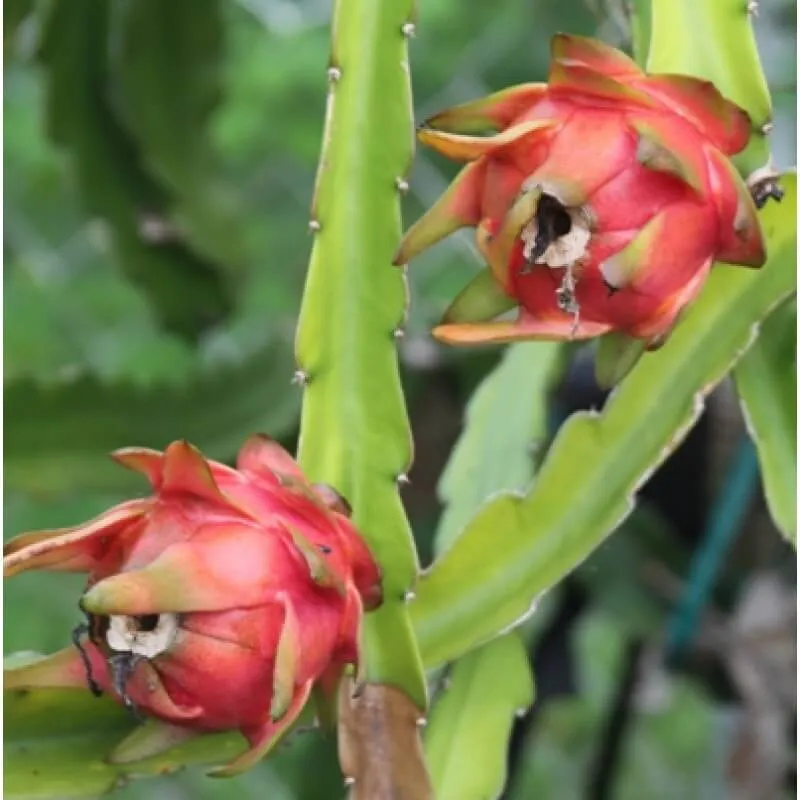
It may not seem apparent, but dragon fruit is related to Cacti. They are a prevalent kind of fruit and are also called pear and pitaya.
The species have different variations depending on its fruit’s appearance. The fruit can have yellow or red flesh, depending on the species.
The fruit is sweet, so you can eat it raw or dried. You may also have it to your salad or even a smoothie.
If you’re someone who likes a little bit of tartness when it comes to fruits, you’ll enjoy eating these fruits.
Dragon fruit is one of the only cactus fruits that’s cultivated commercially. You can also grow dragon fruit in your kitchen garden.
However, you would need the climate to be suitable to produce these. If you live in the United States, USDA zone 11 is something you may be able to grow your dragon fruit.
The cactus can grow its vines, and if you leave them unchecked, they can extend to over 30 feet long.
Most people find growing dragon fruit on a trellis is a better option since you can keep the fruits off the ground.
The soil needs proper moisture so the fruit doesn’t split. You can grow this kind of cactus from seeds or cuttings, and it takes many years to produce fruit and seeds, so you may need to distinguish them.
Saguaro Cactus Fruits
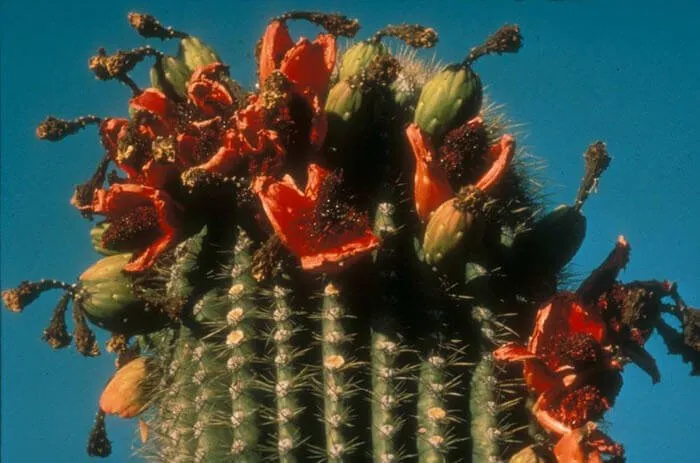
You can grow the Saguaro cactus fruits in the USDA zones 8 to 11, iconic to the American West. These cactus plants are reflective of the American West and are indicators of the existence of a desert.
They can reach up to 40 feet tall, and they won’t start growing any arms until they are 75 years old.
The Saguaro can display huge white blooms in the spring, and fruits will develop and ripen. The inside of the fruits tends to be red with black seeds.
The Saguaro fruit is an essential source for communities living in the Sonoran Desert. Their summer ritual involves gathering and harvesting the Saguaro fruits with much effort. Harvesting the Saquoro fruit from its tree is not easy.
However, the cactus plant can be tall and spiny, which is why it may become difficult for you to reach the fruits. However, if you put in the effort to collect them, you can enjoy the distinct sweetness of these fruits.
Peruvian Apple Fruit

The Peruvian Apple Cactus is expected in the US Department of Agriculture’s zones 9 to 12. It is a columnar cactus that can grow in many different parts of South America.
The cactus can grow in particular conditions. It needs acidic, well-drained soil, and though it can grow in hot temperatures with relative ease, it cannot grow in extreme cold atmospheres.
You can attempt to grow these cactus plants on a trellis and even at heights if that’s where you live. However, it won’t grow quite as tall as you want it to in the right conditions.
This cactus will bloom with off-whitish or cream-colored flowers. The fruit is very similar to the prickly pear cactus fruit. Thus, it has red skin, white flesh, and black seeds.
However, it has more roundness and smoothness than the dragon fruit, which generally has a bumpy surface.
Parts of Europe will call it the Kuobo fruit. The fruit is generally sweet and also refreshing.
Many people enjoy eating it because it resembles shaved ice, and it can be said that it’s a natural alternative to shaved ice.
It doesn’t have any additives, which can turn you away from the taste of all of these. You can also go as far as adding the fruit to a salad or smoothie as it’s one of the easiest ways to get one of the fruits into your system.
Edible Cholla Cactus Fruit
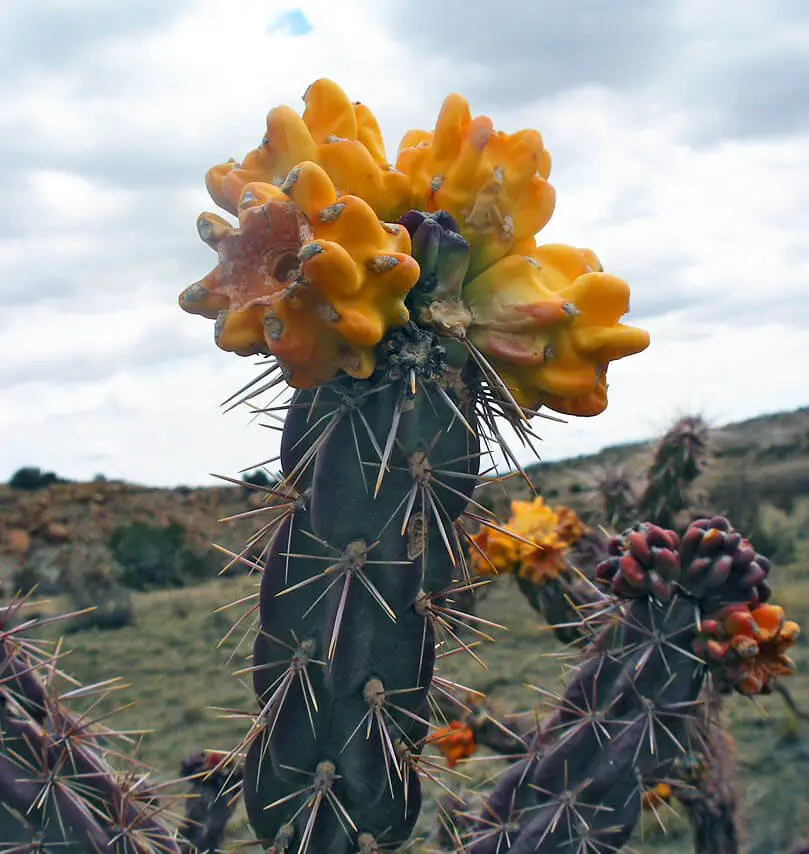
The fruits of the Cholla Cacti are edible, and you can eat them. However, they are not easy to access.
These fruits hang on cacti that look extremely dangerous. They have barbed spines and are called chain-fruit cholla or even jumping cholla.
When the barbed spine catches on something, it could end up making you feel like it’s jumping up on something. The plant can display pink flowers and bunches of fruits.
There is some relief to this cactus fruit because these fruits don’t have spines. Once you extract the fruits, you can simply wash and cut them up to put in your salad or smoothie.
They have the same features as that of the prickly pear fruit. Since they have a subtle sweet taste, you can use them to make syrups, jellies, and jams. The buds in flowers are edible as well.
You can also use the cactus for more medicinal ventures as it has anti-diuretic properties that can make matters much easier for you.
The cactus fruits are much better for your health and can help you feel better than you did before.
Fruit from the Barrel Cactus

The barrel cactus also produces fruits that you can eat. You can use these fruits to identify cactus plants.
The barrel cactus is different from other cactus species because even though the cactus has a lot of spines, the fruit doesn’t. Thus, it’s more accessible. You can easily cut it out and use it in whatever way you want.
You can eat this fruit raw or try to dehydrate it. The fruit is not as sweet as some of the other cactus species that may be available to you in your garden.
However, the lack of a more robust flavor makes the fruit an excellent vehicle for different tastes. You can easily mix it with other flavors and use it in salsas, vinaigrettes spreads, or relishes.
You can also remove the seeds and toast them to eat as snacks or sow them to grow plants.
These cacti take their time but can reach up to 3 feet after sprouting. They have a green trunk with many columns of hooked yellow spines.
This cactus species finds it more accessible to thrive in the scorching desert heat than other cactus species. It also needs proper irrigation and well-draining soil.
The brightly colored flowers later give way to edible fruits. However, this particular species is considered endangered, so you have to be extremely careful with it.
If you ever come across a fruit from the barrel cactus, consider disengaging the seeds and propagating them. Before you start searching for these fruits, know that finding them in the wild is nearly impossible.
Identify Using Sizes
You may not think that size matters. However, the difference in sizes helps you identify the differences in a cactus plant to a great degree.
Cactus plants are very similar, so something like size is fundamental in helping you distinguish the different species. Some species have tall plants. However, other species are short and can pack a punch.
Specific characteristics help you identify which species your cactus belongs to. The most important of these is the height. The cactus species have an innate feature that makes it that way.
The cactus can’t grow beyond a certain height even in ideal conditions due to the species’ nature.
Most cactus plants are shrubs that don’t grow too tall; this makes them better as house plants. However, just because the shorter plants are common doesn’t mean that the tall ones don’t exist.
The taller ones are rare. If you have a tall cactus plant growing in your backyard or the local nursery, identifying it would be easier since they aren’t many tall ones. You are likely to see shorter and taller species depending on where you live.
Most cactus species grow up to 2m. There are species like the Blossfeldia species that are relatively small and can have a maximum circumference of about 12 millimeters.
The species is formally tiny and makes for great house plants. You can even gift it to someone who’s headed to college. More information is available on smaller cacti; so, you’ll find it easier to know which ones you can use at home and which ones you may need to move outside.
Size can be useful for indicating the species of your cactus plant and whether you can keep it inside.
The diversity in the family cactus species is exceptional. You will find all kinds of cactus plants there. There are species like the tree-like 10 meters tall Browningia that share characteristics with the smaller Blossfeldia species.
Apart from this, there are also species like the humongous Saguaro tree known as a Carnegiea cactus which is generally the cactus you see in all the movies set in the Wild West.
It is tall and three-tiered. Its symmetry makes it perfect as a prop for desert movies. These cactus plants can grow to an extreme height.
The desert skies can grow up to 50 ft tall without stopping, and reaching this maximum height does not require any human intervention. It also offers a stable source of comfort and shade to desert animals.
Size is also helpful when identifying cactus species because the environment the cactus plants grow in dictates this factor. You may not always know where the desert species are coming from, which is why it’s necessary to look into all of the possible species that your plant may be a part of.
For cactus plants, size is not limited to their length but also their circumference and general area. Some species of cactus tend to get more focus than other species.
Smaller cactus plants are easy to overlook, and you might miss out on some beautiful plants. One such plant is the diminished Cleistocactus.
It has prominent spines and colorful flowers. These features ensure the cactus plant is protected and can reproduce.
The features make it all the better for protection and reproduction. The sizes of the cactus plant will help you identify which general species your cactus belongs to.
Many people need to know what kind of cactus they have so they know how to take care of it.
Noticing a cactus plant’s physical features is a common way to identify its type. You should be careful that height only becomes a feature when you have the right environment.
You can’t just use height or size to identify the cactus species. Instead, you would need at least two more properties for all problems.
Shape Your Cactus
Now that we’ve talked about your cactus’s size, we can also talk about another physical aspect of your cactus that’s closely related to size, which is shape.
Cactus plants are some of the most adaptable species of plants, and that’s why they can take on weird, unique shapes.
The Shape also happens to be the one property that strikes the person looking at a cactus immediately. The most popular shapes for cactus plants are columnar and rounded shapes.
Cactus plants can be found in many interesting-looking species, and you won’t always be able to identify the species when you encounter one.
There is a lot of shape diversity in cactus plants, so you may not know which ones belong to what species.
However, if you want to figure out what cactus species your cactus belongs to, the shape of your cactus is a good place to start. Some species may transfer and go through quite a change as they mature.
This change can also help you identify all of the ways your cactus is different from others. You may also know whether the cactus is in the adult phase of its life or if it’s younger.
You may be aware of many species that undergo changes with time. For example, the Geohintonia species starts as globules but becomes more columnar as it grows.
However, the changing of the shape doesn’t happen immediately. It happens over a long period. If you have the luxury of observing your cactus plant as it grows, you may be able to identify its type from its shape.
Columnar and globular cacti don’t have a lot of overlap, except there are many columnar cacti that start off as globular. When cacti are younger, you can’t identify which shape they will take.
Much of this has to do with the fact that many features evolve over time. If something starts out like a globule, it can then turn into a columnar.
Most cacti species either have cylindrical trunks that can grow to a certain height or are more rounded and globular cacti, growing in circumference and area. You can even have star-shaped cacti that are mostly the shapes associated with the cactus.
These are some of the most common species you may associate with a cactus. However, we also find that there are some other shapes that may be available to you.
There is a prominent member of the Hylocereus species that can occur in an all too winding manner. These plants can climb up the tree trunks.
These species are epiphytes which means they’re different from cactus species in their adaptability. Thus, they grow in more moderate conditions than you’re regular run-of-the-mill cactus species.
There is also the genus of the flat, smoother, mat-like Maihenia cactus. It has many segments that stem from the deep cushions in the ground, making this cactus easily identifiable.
There are many cactus species that have other shapes and sizes. However, you’re unlikely to come across them too often. If you do come across them, you’ll know how to identify them.
There are also cactus species that have a more defined shape that many people tend to romanticize to a great extent. The barrel-shaped Ferocactus is considered a savior in dry regions without water.
It has a vast tank right in the middle of the cactus, which can help any wanderer in the desert who’s hoping for a drink. There are certain shapes that make the Cactus plant all the more distinctive.
The Cephalocereus species also exist, which is larger and more columnar, and thus, you’d find differentiating one species from another difficult.
You can identify all of the species that the cactus may be a part of. It’s necessary to see whether the cactus you own has any of the features of a cephalocele species.
You may find that it’s easier for you to look deeply at the physical aspects of it all before you can look at anything else.
We can guarantee that almost all cactus plants have very significant features that set them apart from the rest.
One of the features you may encounter is a ribbed trunk in the shape of an accordion. It can be found in the cacti belonging to the Cereus species.
The trunk will be ribbed. Though their water storage pockets are not aesthetically pleasing, they serve an important purpose. We will also find that not all cacti can feature ribbed trunks.
Many cactus plants are known for their ribbed texture, and the cereus species is one of them. It can have a total of 5-10 ribs per species.
You may not know all the ways that the shape has come to be over a period of time. However, it’s necessary to know how things may transpire.
The climatic conditions are essential for knowing which species of cactus plants are prevalent. By identifying the species of the cactus plants you have, you can learn how to take care of them.
You can also work on maintaining the shape of the cactus plant by ensuring it gets the protection it needs. If you’re looking at a cactus plant where you don’t quite know its origin, do a thorough examination.
Spines
You may not think the spines can tell you much about the cactus plant. Not only are they cactus plants’ most prominent feature, but they are also considered important among features that help the identification of their species.
These spines are all over the place on your cactus plant. You may not think that they’re different, but they can actually be quite nuanced. The spines that protrude from the fleshy stems in cactus plants are quite different, and you may not always know how to go about defining them.
However, the different spines which are present can give you a lot of information that you may require when identifying the cactus plants.
Spines may not just arise from the fleshy stems in cactus plants. Rather, you can also have spines coming in from the fruits in a plant.
Most species of a cactus plant can bear the defining characteristic of spines on fruits along with spines on other fleshy stems. However, there are species like Ariocarpus that don’t have any spines on them.
If you find that there are spines on your cactus, then you will find that it’s easy to identify the kind of cactus that you’re harboring.
These cactus plant features are easy for you to notice as you can clearly state whether certain features are present or not.
You will also find that they help you narrow down categorization to you, so you don’t have to wonder about the many other species of cactus plant that you may be attracted to in your garden.
There’s also much to be said about the spines and their shape altogether. There is a lot of variation in cactus species, and you can identify these species by understanding the differences in spines.
The spines can be thin or stout. They can also be scarce and dense depending on the specific plant and how its morphology will affect its shape and size.
Some cactus types may feature straight spines, while others might have more hooked variations. You may want to observe these features carefully so you can note the many differences and identify different species of cactus plants.
The composition of the spines can also be vastly different than others. They can be flaccid and hair-like, or they can occur in the form of a hard protein like pectinate.
Depending on the cactus in question, you can make assumptions or inferences about the species to that the cactus may belong to. If you see hair-like bristles, the adaptations of the cactus might be completely different from that when the cactus has hard spines.
Some cactus spines are shinier due to the cactus having a layer of wax on the spines. Not all cactus plants have shiny spines.
So, if you have one that does, you may find it easier to categorize the type of cactus you have in your backyard. If you look at it, you’ll find that the cactus gives away its identity in many ways.
Cactus spines can also be rough and dry. The drier the cactus spine, the more brittle it is. Cactus plants have spines in place of leaves.
These spines are covered in wax allowing certain cacti to save the maximum amount of water they can on any given day.
It is necessary to note that some spines even have grooves and striations on them. These grooves and striations help the spines carry even more water.
Some that don’t live in climates that are as harsh would have much smoother spines. While spines tend to grow anywhere on the cactus plant without any proper symmetry, there are also those that have some order to them.
Species that have a more organized growth can sprout spines that are only present on the ribs. When this happens, you can get a better understanding of the type of cactus that you have.
Another feature of the spines on your cactus plant is areoles. These are the places from where the spines rise.
You can find areoles in specialized branches or roots. Certain cactus spines are stronger than others. Some cactus spines are delicate and can break easily in your palms. At the same time, there are others that are extremely strong and maintain their shape for as long as they exist.
The spines that are stronger than others have a more grounded areole. They are firmly present in the areole, which means they can just as well remain in their positions enough to hurt you or pierce through your skin.
There are other more weak versions, such as the Frailea, which has feather-like spines that are so weak and fragile that they cannot withstand any kind of pressure. Even something as simple as the bump from your fingertips could be enough to cause them to break down in your hands.
The strength and frailty of the spines can also help you identify all the ways in which the cactus plant is different than the rest of the cactus plant.
There are species with stronger spines and ones with weaker ones. Thus, you can always use these identifiers to figure out which species your cactus plant will belong to.
There are also certain cactus species with colored spines. These spines are then easier to gather. These spines can also be set up in a more patterned way.
There is also the exceptional attribute of younger cacti to grow many spines altogether. These spines can then slowly reduce in number as the plant ages even more.
Stems That Set Your Cactus Apart
Apart from the other attributes we have mentioned, there’s also the case of the stem being the right kind. If you’re trying to find the difference between two different cacti, the answer is likely a culmination of all the different attributes we have recently mentioned.
There are many different stems that exist in all the different cactus species. If you want to identify which cactus stem is closest to the cactus you have in your backyard, consider learning about the different types.
The stems of a cactus plant can be different in their aesthetics. You can have smooth stems or stems that are mostly littered with spines.
There are stems with more of a ribbed texture, and some even have areoles emerging from them. Some areoles are close together, and others can be completely away from each other.
It’s necessary for you to know what different cactus stems indicate before you start comparing them with the stems of the cactus you own.
Stems are some of the most prominent aspects of cactus plants. They tend to stand out and are clearer to see, which is why it will be easier for you to identify all of the ways in which your cactus may or may not belong to a certain species.
Within the stems, the most prominent parts are the areoles. There are stems in which the areoles are packed against each other neatly.
You also have to understand that the areoles are the points from which the spines tend to arise. The arrangement of these spines is what allows you to notice whether there’s a jointed stem or not.
There are also certain tubercles on the plant that gives you information regarding the cactus species.
These are pustules-like growths on the stems that set it apart from other species. Not all species have these pustules on your cactus stem. However, some of them do. If you find these tiny projections present on your plants, you can have a better idea of what species they belong to.
They are warty-like in their growth and can appear on any sort of plant. These are rounded in shapes and look like really big pimples.
Round tubercles are a more common occurrence in cacti. However, there are also tubercles that can exist in the form of triangles. The triangular tubercles are likeliest to exist in the Leuchtenbergia species.
The stems and their height and shape can also tell you about which species the cactus plant belongs to.
If the stem is more globular, the cactus plant might belong to a different cactus species that tend to be in this shape.
If you see a cactus plant that is more columnar, it’s likely that it’s closer to cactus species that are more columnar than rounded or globular.
Geographical Locations
You need to note all the ways geographical locations can affect the species of cactus you encounter.
Depending on your location in the world, you’ll be able to know which species your cactus belongs to.
We aren’t suggesting you should only go by the cactus’s location for identification. However, you need to note the geographical location since it’s an important factor.
If you have looked at all the different qualities in the cactus and are having a difficult time figuring out which of the species your cactus plant belongs to, try using geographical location for identification.
The ground on which the cacti grow can tell you a lot more about their species. The cactus growing in the backyard will have grown or regrown there, and this can help you deduce its identity.
Cactus can survive in all sorts of settings. However, cactus plants also need to thrive all the same.
They also need to have a set of preferred conditions that allow them to thrive. There are different types of conditions that the plants may prefer.
Some cactus plants prefer more extreme conditions, and others require much more mild ones. Cactus plants can do better in a number of settings.
They can do well in arid regions with some extreme climates, and they can do well in alpine regions which have an extremely cold climate.
The differences that cactus species share are great for their identification. You may not always know where to start, but geographical location narrows down your search to quite a degree.
Some cactus plants grow in places where there’s a lot of moisture and humidity. Here, however, the cactus plants don’t act like xerophytes but are better suited to being called epiphytes instead.
The complete list of attributes we have mentioned above can help give you an idea of how to categorize the cactus species that you may come across.
You can go through the list and identify the cactus plants through a process of deduction. We recommend you look at the size and shape of the cactus plants first.
The size and shape are some of the most important giveaways of the species to which the plant belongs.
The flowers and fruits are more specific, so they can also help you identify the type of cactus plant. However, the problem with using flowers and fruits for identification is that these features take a fair amount of time to develop.
If your plant is just starting to root, you might not be able to use this method.
The fruits of a cactus plant can only grow after a long period. They’re also helpful in identifying cactus species.
A number of cactus species produce flowers and bear fruits. Since fruits develop in more specific ways, you can find out whether a fruit belongs to a certain species of cactus or not. You can identify a cactus from its fruit’s physicality and taste.
Cacti plants tend to capture people’s imaginations and attention because of their shape, properties, and resilience.
Much research has been done by scientists and botanists globally to identify its different species. If you have multiple cactus plants that you want help in categorizing, you may want to make a list of all the potential categories under which the cactus plants could fall.
Later, you can list all the categories your cactus shares and find out the correct species.
Types of Cactus/Succulent
Now that we know there are many different types and categories your cactus can belong to, we can look into the many types of cacti and succulents as well.
People tend to consider cactus and succulents as one and the same. However, they are different from each other in many ways.
The most prominent difference is that succulents don’t have needles or spines, and cactus plants do.
However, Cacti plants and succulents all come under the umbrella of xerophytes, which means they’re likely to adapt to extreme conditions for survival.
Some of the many different types of Cactus plants are written below:
1. Christmas Cactus
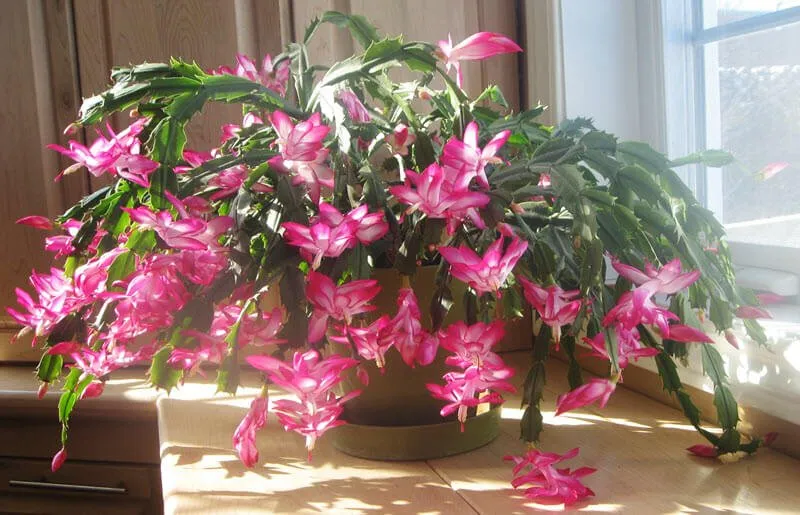
The Christmas cactus is known for being one of the prettiest cactus plants. When it blooms, it is bright pink and can return year after year in every holiday season.
While most cactus plants are used to a dry climate, the Christmas cactus prefers a more humid climate since it requires more moisture.
These plants are also not desert-dwelling, as they were first found in shady, moisture-filled parts of Brazilian forests. Hence, you should give these cactus plants ample water so they may grow.
2. Barrel Cactus
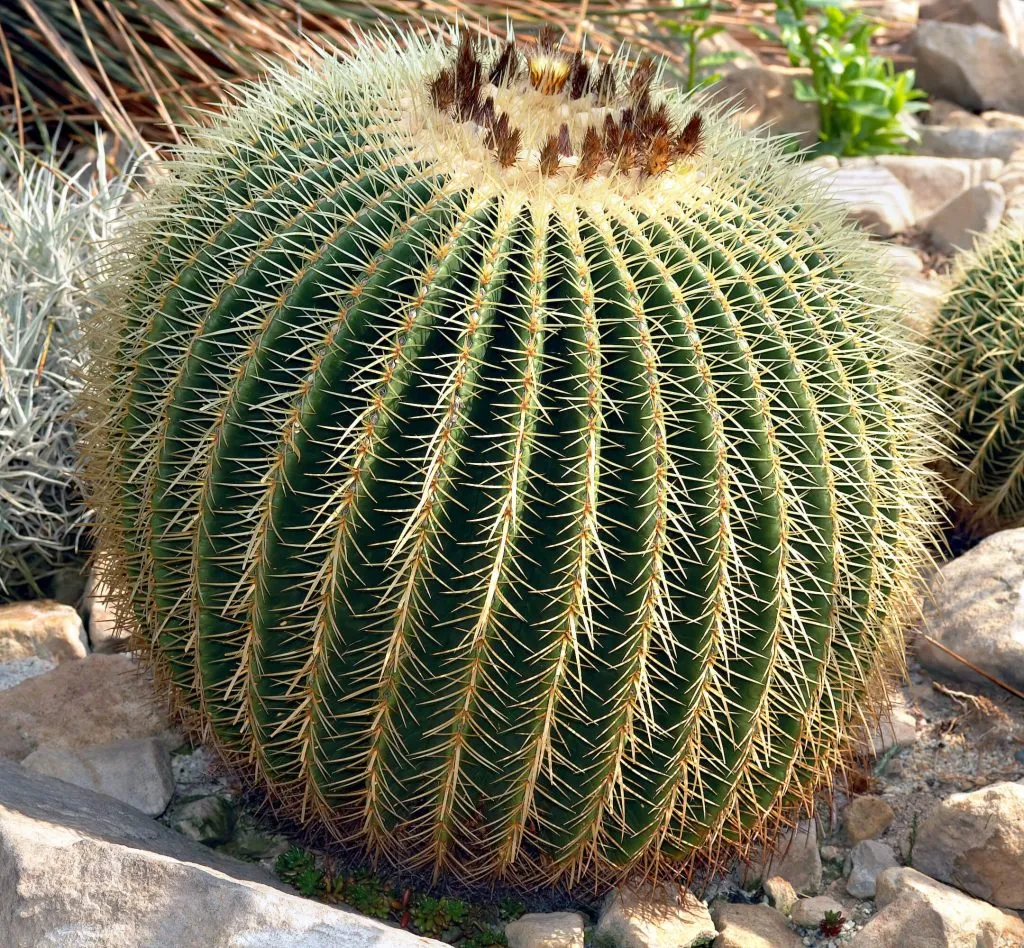
You will have no problem identifying this cactus since it resembles a barrel. It is also called a mother-in-law cushion because it looks squishy even with all the needles protruding from it. It needs a great amount of water and sun to maintain its shape.
However, the good thing about this cactus plant is that its minimal maintenance, which means you don’t have to water it quite so frequently to get results.
3. Fairy Castle Cactus
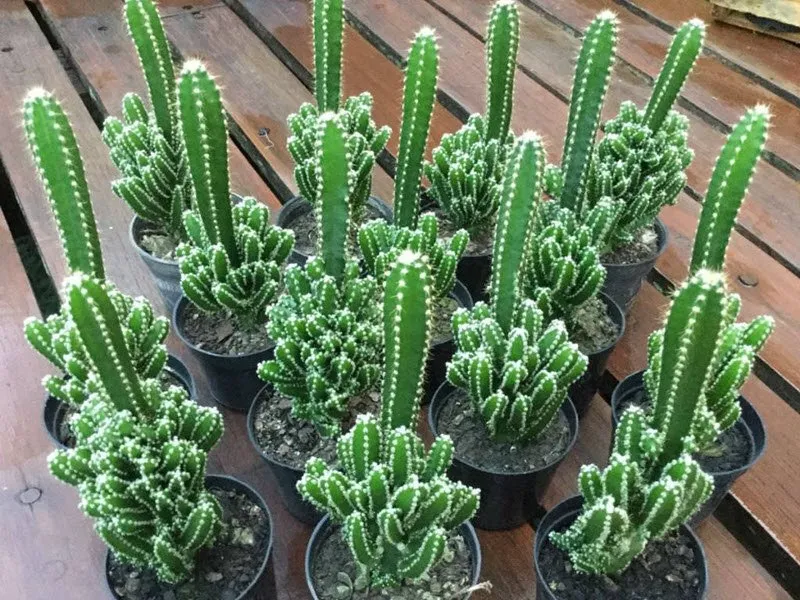
This cactus can be the cactus of your dreams. Its stems have varying heights, making them resemble the turrets of a castle. It will stand out and grab people’s attention when added to your collection.
They can grow up to be very tall. It might even become the tallest cactus in your garden. The Fairy Castle cactus grows slowly, but your patience would be rewarded in the form of vibrant flowers that bloom on its body.
4. Saguaro Cactus

We’ve talked about this cactus a lot because it’s one of the most popular varieties. If you live near California or Mexico, you have most likely come across this cactus.
It’s an extremely hardy cactus, which means it can often last a long time and live up to 200 years. You may not think that it can grow indoors because of its height.
However, it only grows an inch per year for the first eight years of its life, which is why it’s possible to grow it indoors.
5. Star Cactus
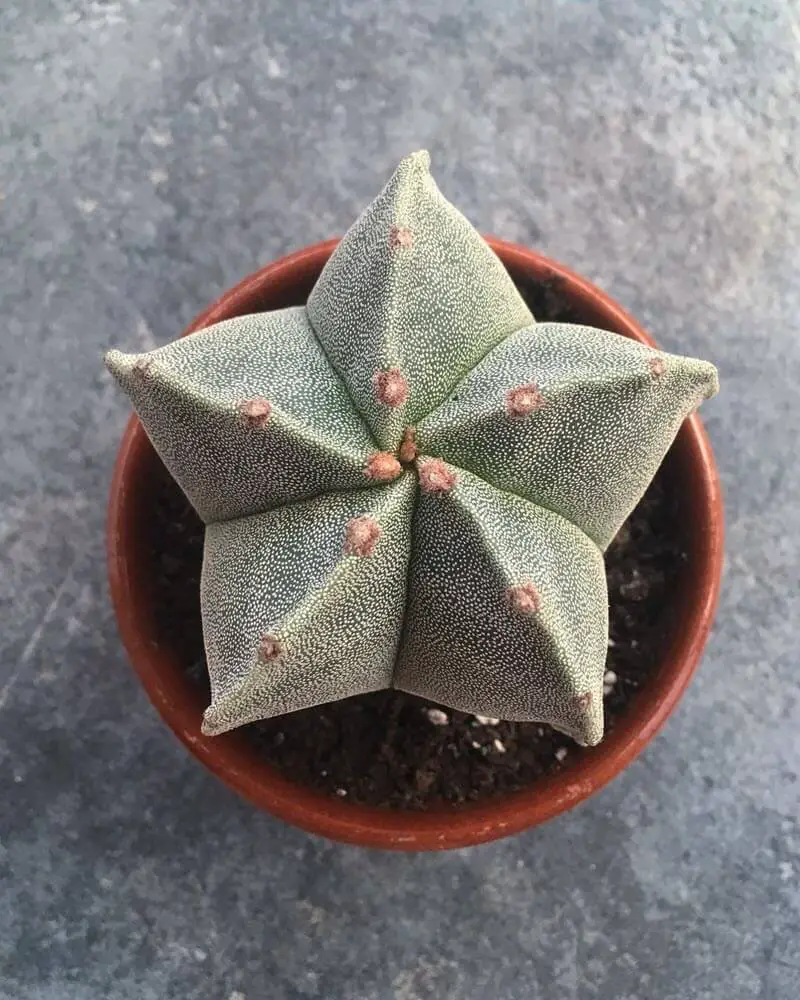
This “star” in the star cactus’s name refers to the fact it looks like a sea urchin or a starfish. It is a small plant, which means it’s perfect for a succulent garden.
You can find it with many flowers and blooms that make you feel right at home on a petite cactus. If you want something cute and small for your dorm room, the star cactus is the perfect addition to your home. It doesn’t require a lot of effort, so you can get away with a little neglect.
6. Feather Cactus

It may fit your aesthetic if you’re into cactus plants that look more snow-like in nature. However, while they do look fluffy, feather cacti actually hide many of the main spines that may cover the surface. Feather cacti have a lot to offer. However, you have to be careful around them as well.
7. Old Lady Cactus
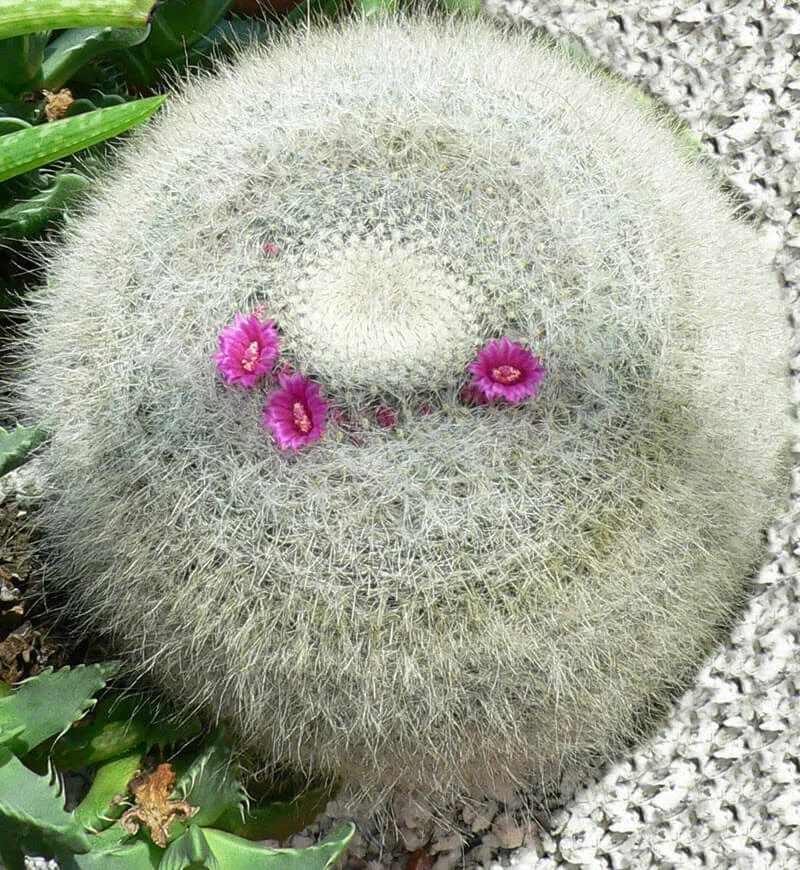
This cactus is also like a puffy cactus. You can find that it’s covered with spines and white down or feathers which is where it gets the name old lady cactus.
It’s a plant that most find extremely easy to grow in their backyards. The cactus is also simple, and you can grow it even if you’re just starting to learn how to grow plants of your own.
8. Bunny Ear Cactus

The cactus gets its name due to its shape, which makes it look like cute bunny ears are sprouting. It doesn’t have spines like a regular cactus.
Instead, it has glochids or tiny little bumps that can still hurt you but with less force. These cactus plants will be ideal for keeping in your home and decorating your room if you like cute things.
9. Blue Columnar Cactus
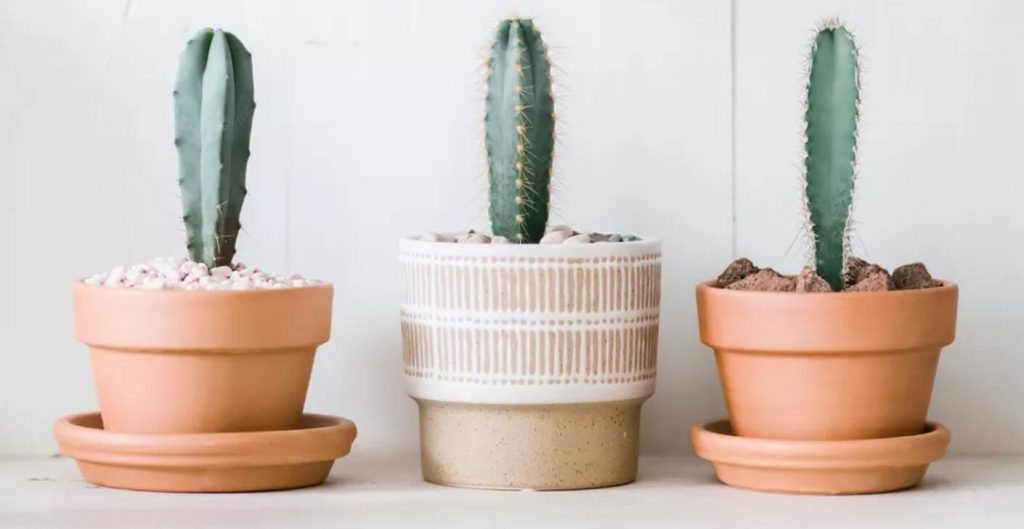
Blue Columnar Cactus: A columnar cactus (also known as a columnar cactus) is a type of plant that is a member of the Cactaceae family, which also includes all other cacti. The name “columnar” refers to the arrangement of the cactus’ stems, which look like a column of bricks from a distance.
The blue columnar cactus (A. columnar is) is a particularly interesting species. It is a columnar cactus (cactus with a column-like structure) that has a ruffled, blue-grey head of spines. The blue columnar cactus is native to the Chihuahuan Desert of the United States and Mexico.
This cactus can reach heights of thirty feet when they’re mature and has full funnel-shaped blooms that occur on its best days.
10. Moon Cactus
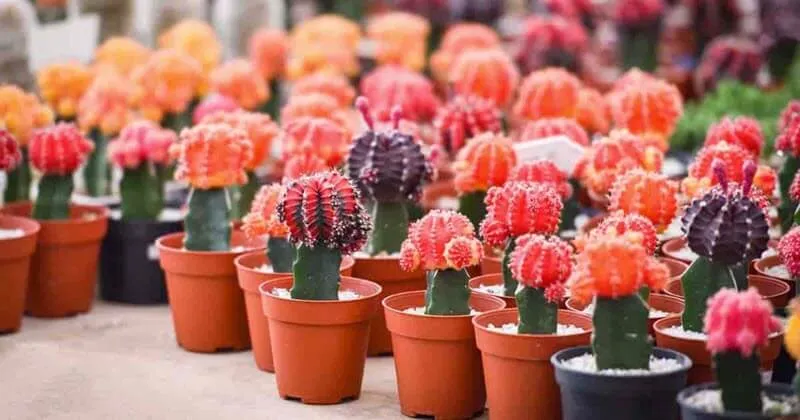
It has a bright color that sets it apart in your succulent garden. It’s a hybrid plant, which means it has the genes of more than one cactus.
This cactus is formed by grafting two different cacti together. They have lifespans that are actually short compared to other cactus species.
Final Thoughts
There are many reasons for identifying which species your cactus plant belongs to. Knowing the species means you have a better idea of what your cactus plant should look like when it’s healthy and whether or not it’s growing at the pace that it needs to.
Thus, it’s necessary for your cactus plant’s growth that you know what species it identifies with. We hope that the comprehensive list we made helps you identify the species more easily.
The saguaro is an icon of the American Southwest, and it is easy to identify, thanks to its height, its branching arms, and its white spines.
It is a cactus that is easy to learn to identify and care for, and it is a plant that will be a delight in the yard, both because of its beauty and its hardiness.
